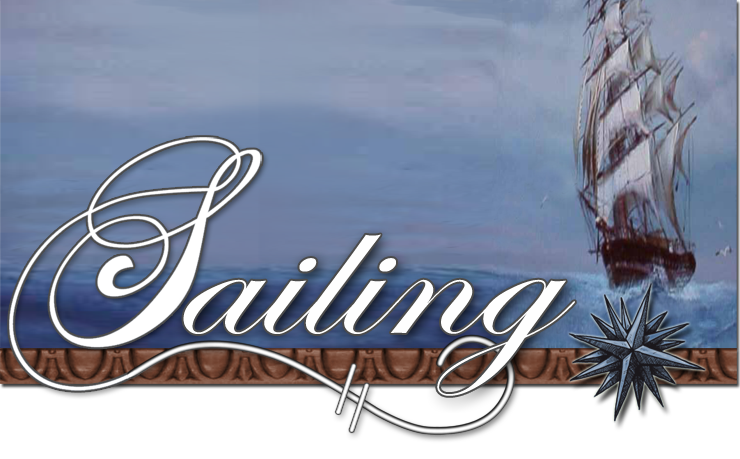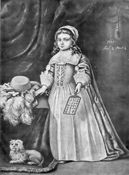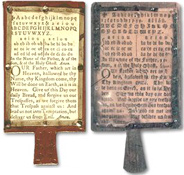
|
||||||||
| Back to Sailing Main Page
The Pirate Stede Bonnet was famous for the library he carried aboard his ship. But how did children of the 17th century learn to read? By memorizing the alphabet from a hornbook, a handled wooden board with a thin layer of vellum (or "horn") printed with the English letters, the vowels, and lines from the Lord’s Prayer. Teaching from the hornbook would start when a child was as young as three, hence the wooden board which was sturdy, and the vellum which could be replaced if torn. After learning the letters and the vowels, the child would learn the consonants (literally con sonant, from the Latin "with sound," meaning that these letters had to be combined with vowel sounds to be spoken — em, tee, ess, etc.). Then came syllables in greater complexity, and memorizing the psalms from a Psaltery (more on that in another post), and by the age of six an English child could sound out — read — the words of the King James Bible. Modern education has stepped away from teaching by phonics, but for centuries it was a fast and effective learning technique.
|
- Home
- About
- Books
- Doc Holliday Stories
- An Evening with Doc Holliday
- Leadville Takes a Shot
- Designing Doc Holliday
- Why Doc Holliday Killed Johnny Ringo in “Tombstone”
- Why Doc Holliday Went West
- Doc Holliday: Before the Legend
- The Mysterious Dr. Holliday of Dodge
- Doc Holliday’s Family Affair
- Doc Holliday & Dr. Long: Bringing Life to a Legend
- Doc Holliday and the Ghost of Ed Bailey
- Graves in the Garden – Doc Holliday’s Family & The Civil War
- Fire and Ice: Doc Holliday in Philadelphia
- The Face Behind The Fireplace
- I’m Your Huckleberry
- Bringing Doc Holliday Home
- Tucson, Trainyards, and Festival Tents
- Haunted by History
- Doc’s Last Cold Days
- Doc Holliday’s Florida Getaway
- Searching for Doc’s Grave
- St. Louis and the Southern Son
- An Irish Blessing
- Doc’s Holliday in New Orleans
- Roads To Tara
- Haunting the Holliday House
- Sunset for a Southern Lady
- Dancing with Doc Holliday and Rhett Butler
- On Writing
- Events
- Contact
Recent Posts
- An Evening with Doc Holliday
- Leadville Takes a Shot
- My Process
- Designing Doc Holliday
- The Power of Point of View
- The Power of Story
- The End?
- Why Doc Holliday Killed Johnny Ringo in “Tombstone”
- Why Doc Holliday Went West
- Doc Holliday: Before the Legend
- The Mysterious Dr. Holliday of Dodge
- Doc Holliday’s Family Affair
- Doc Holliday & Dr. Long: Bringing Life to a Legend
- Doc Holliday and the Ghost of Ed Bailey
- Graves in the Garden – Doc Holliday’s Family & The Civil War
- Fire and Ice: Doc Holliday in Philadelphia
- The Face Behind The Fireplace
- I’m Your Huckleberry
- Bringing Doc Holliday Home
- Tucson, Trainyards, and Festival Tents
Copyright 2021 Victoria Wilcox Books
Website Designed and Maintained by Mindwhirl



